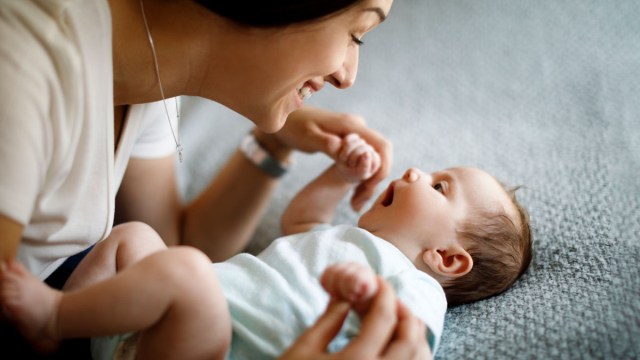You know your newborn has a lot of growing to do: There are inches to gain, milestones to meet, social connections to make. But have you ever thought about your baby’s five senses? After all, there’s a lot to see, touch, smell, taste, and hear outside the womb—and your infant will use their senses to learn about the world around them.
“All the senses need to develop together, in an interconnected and synergistic manner, for a child’s development to remain on track,” says Colleen Kraft, a pediatrician at Children’s Hospital Los Angeles and former president of the American Academy of Pediatrics (AAP). That being said, every kid is different, so consider this a broad guide to typical sensory development.
As they grow, your baby’s senses will help make them the kid (and adult) they will one day be! But how and when do these five senses develop? Whether you’re wondering how much your newborn can see or why your eight-month-old prefers applesauce to peas, here’s everything you need to know about your baby’s growing senses.
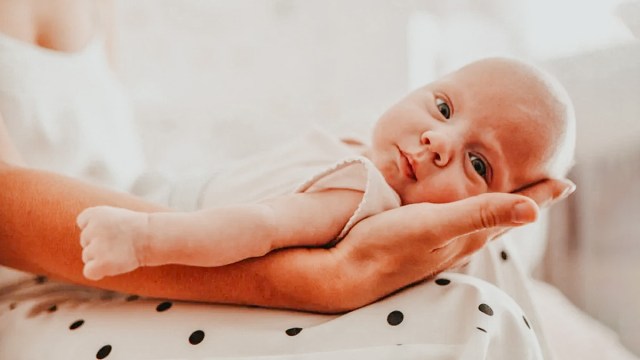
1. Your Baby’s Sense of Sight
It may seem like your brand-new baby is gazing wisely at the world around them, but the truth is they can’t see much.
Sure, your baby’s peepers started working in utero (studies show eye movements begin about 15 weeks gestation), but newborn babies have blurry vision at birth and can only see about 8 to 12 inches from their faces. That’s OK, though! That’s all they need those first few days when just finding the nipple of a breast or bottle is their most important task.
According to the American Academy of Pediatrics (AAP), babies can see bright colors within the first few weeks of life but likely can’t see differences in shades of colors until they’re 2 to 3 months old. This is because the nerve cells that control vision aren’t fully developed until a few months after birth.
“We are born with eyes; these are the cameras that take pictures of the world,” says Alexander de Castro-Abeger, an ophthalmologist in Los Angeles. “We are also born with a brain; the brain is responsible for what we think of as ‘vision’ and seeing the pictures the eyes are taking.”
In other words, your baby’s eyes—and the connections between the eyes and the brain—need to develop for them to see the world fully. Here’s how that happens:
Your Baby’s Eyesight Timeline
At birth: Your baby can see a blurry 8 to 12 inches away—about the distance from your arms to your face. (Despite the fuzzy picture, she’ll know who you are because she can smell and hear you.) In those first few weeks, your new baby’s eyes are very sensitive to bright lights (the womb isn’t exactly well-lit), so don’t be surprised if they shut their eyes or squint when you walk into broad daylight. Also, it’s normal for your baby’s eyes to look cross-eyed or to “drift,” though a constant cross or drifting is not typical and should be evaluated, Castro-Abeger says.
By 4 months: Your baby should be able to align their eyes and track a well-contrasted object, light-up toy, or face. They should also be able to focus on a variety of smaller objects and tell the difference between colors (especially red and green), according to the AAP. This is also when babies start to develop depth perception.
By 6 months: Your baby should be able to see things across a table or room and notice them.
By 12 months: A baby’s vision is close to normal adult levels, according to the AAP (though hand-eye coordination still has a ways to go).
Signs of Vision Problems in Babies:
- While it’s normal for newborns’ eyes to look like they’re going in different directions, it’s worth a call to the pediatrician if this continues past 3-4 months, Castro-Abeger says. The same goes if your baby doesn’t seem to be looking at your face but instead looks past or around you.
- If you take a photo or look at the baby monitor and notice a whiteness in your baby’s pupils, this could indicate a potentially serious condition called leukocoria, which requires quick medical attention.
- If your baby isn’t tracking objects by around four months, let your pediatrician know.
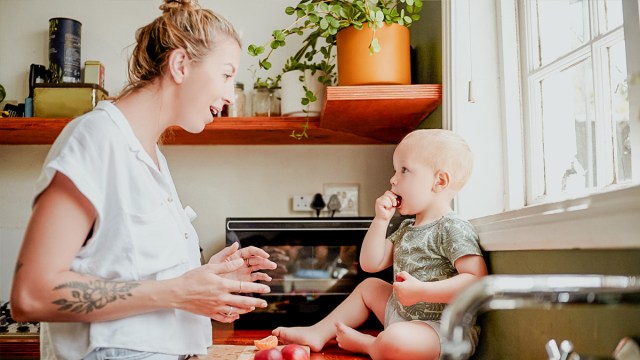
2. Your Baby’s Sense of Hearing
There’s a reason doctors tell you to talk to your belly while you’re pregnant: Your baby’s hearing starts working around 18 weeks gestation and is nearly fully developed by birth! While the first sounds your baby will hear will be the sound of your heartbeat and the blood rushing around them, the muffled sounds of the outside world make their way through as your baby grows.
In fact, studies have shown that newborns prefer music they heard in utero, displaying decreased heart rates when exposed to that same tunes. Even more amazing? Babies can recognize their mothers’ voices as early as one day after birth, as suggested by this 2014 study showing babies sucked harder on a pacifier when they heard their mothers’ voices as opposed to those of other women.
Healthy hearing doesn’t just make your baby’s world more interesting—it also helps their overall social development. According to Kraft, who teaches Clinical Pediatrics at the Keck School of Medicine at the University of Southern California, infant hearing problems can lead to a host of other deficits, including delays in language and social development. “Hearing loss can prevent other normative social-emotional bonding activities from occurring,” Kraft said. “This bonding is the foundation of early learning.”
Note: A baby’s ears are more susceptible to damage from loud noises, so care should be taken to keep your baby away from loud environments or to protect your baby’s ears if you have to be someplace loud (after all, research has shown that babies love live music just as much as we do).
Your Baby’s Hearing Timeline
At birth: If your baby was born in a hospital, they likely had a newborn hearing test done there at birth (if you had a home birth, you should make sure your baby has a hearing test by 1 month old). Assuming your baby’s hearing is developing typically, Kraft says a newborn baby should:
- respond to or turn toward high-pitched sounds and voices
- startle at unexpected noises
- may be able to respond to the sound of your voice or lullabies you sing (especially if they heard them in the womb)
By 3 months: By the time a baby is 12 weeks old, the temporal lobe in their brains (which controls smell, hearing, and language) is better developed, allowing infants to process more of what they hear. Consequently, babies at this age may:
- look at you when you talk or sing to them
- smile at you when you speak or sing to them
- try to “talk back” by gurgling or cooing
- wake up because of loud sounds
- stop feeding or sucking in response to a noise
By 8 months: At this age, babies can usually:
- locate where sounds are coming from and turn their heads toward new sounds
- respond to whispers
- listen to you when you speak and “respond” with babbling
- understand basic words such as “bottle” and “milk”
By 12 months: Babies begin to assign meanings to words and imitate sounds. By the time your little one is a year old, Kraft says they should be able to:
- respond to simple requests such as “come here” or “roll the ball”
- imitate some speech sounds
- enjoy being read to or sung to
- point to simple objects in books they recognize
- use a variety of consonants at the beginning of words
Signs of Hearing Problems in Babies:
Kraft said parents should talk to their pediatrician if their infant isn’t meeting any of the milestones listed above. It’s also worth a call if your baby looks toward you when you move into their range of vision but ignores you when you say their name.
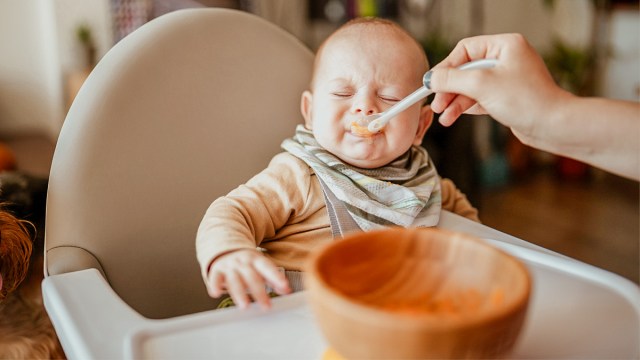
3. Your Baby’s Sense of Taste
Your babe may not be a picky eater yet, but their taste buds have been around for almost as long as they have! They form at about nine weeks in the womb, which means your baby can taste what you’re eating via sips of amniotic fluid during much of your pregnancy.
They may even have preferences. A 2022 study showed babies in the womb gave “laughter-face” reactions after their mothers ate carrots and “crying face” reactions after they ate kale (we feel you, babies; kale is an acquired taste).
“Taste preferences develop pretty early,” said American Academy of Pediatrics spokesperson Whitney Casares, an Oregon pediatrician and author of Doing It All: Stop Overfunctioning and Become the Mom You Can Be. “You’ll see kids when they first start solid foods; they’ll try avocado or vegetables and they’ll make a yuck face.”
Your Baby’s Taste Timeline
At birth: Your newborn has nearly twice the number of taste buds as you—including buds in the tonsils and the roof and sides of the mouth. Scientists think these added taste buds help make babies more receptive to their mothers’ milk.
By 4 months: Research suggests that your baby can’t taste salt until about this age. But don’t try to give them salt anyway; experts say kiddos shouldn’t have added salt until they’re at least one year old since their immature kidneys can’t flush it out as well as adult kidneys can (there’s enough sodium present in breast milk, formula, and common baby foods).
About 4 to 9 months: Infants begin to discern different textures at this age, which will help them when they start eating solid foods. This is a good time to get your baby teething toys and board books with different textures, Casares said, so they can explore these sensations (with both their fingers and mouths).
By 12 months: Babies might start to show marked preferences for certain foods, but parents should keep offering a variety of tastes and textures, adding that “it could take 30 times of trying a food for a baby to like it.”
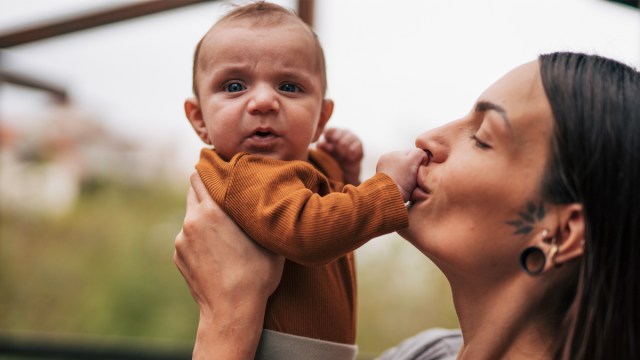
4. Your Baby’s Sense of Smell
Your baby’s sense of smell is one of their strongest senses, being fully developed by the time they’re just 24 weeks in the womb!
In fact, studies show that babies can recognize the scent of their mother’s breast milk shortly after birth, thanks to having been exposed to it for many months in utero. This ability to recognize Mom’s particular smell is an important evolutionary step that helps little ones connect with their mothers in those first few days when their vision isn’t fully developed. (Don’t worry, dads and partners! Babies will eventually smell you, too.)
“When you think about it, smell is one of the most basic ways a baby can interact with the world,” explains developmental pediatrician Jennifer Poon, medical director at the Center for Pediatric Development, Behavioral Health, and Wellness at the Medical College of Georgia. “They’re not yet processing other things as much, so they’re really using their innate senses to process the world.”
Your Baby’s Smell Timeline
At birth: A baby’s sense of smell is fully developed by birth. This super-sniffer helps them recognize and enjoy the scent of their mother’s milk within minutes of birth (which helps encourage feeding). By two weeks, studies show babies can usually recognize their moms by their body odor alone. If a baby is formula-fed, they will learn to recognize and enjoy that smell, too.
By 3 months: Babies can recognize the smell of other parents and familiar caregivers, Poon says.
By 8 months: When trying solids, babies may reject foods that have unfamiliar smells, so be sure to expose your baby to all sorts of flavors while you’re pregnant—and continue to cook lots of different foods so your baby can become familiar with their smells even before they try them.
By 1 year: If your babe has a hard transition with their babysitter or at daycare, it may be helpful to leave behind a blanket or piece of clothing that smells like you.
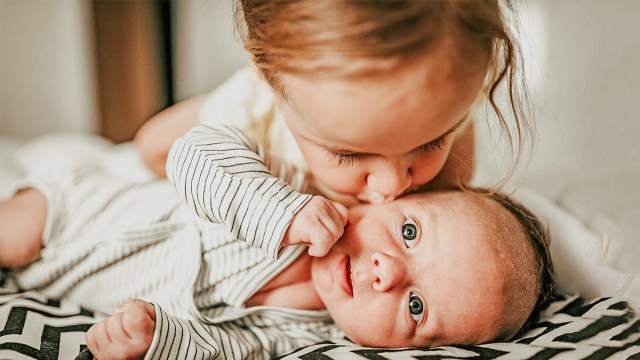
5. Your Baby’s Sense of Touch
Touch is the very first sense to develop, forming only a few weeks after conception, according to What to Expect. This isn’t surprising—after all, touch is one of the most important building blocks for a child’s health and emotional development—helping babies bond with their caregivers and connect with the world. (So yes—more cuddles!)
As babies grow, touch becomes an invaluable way to explore the world as they pat, poke, prod, hold, hit, grasp, hug, squeeze, and mouth (another form of touch) anything within their reach.
“Touch is such an important thing for babies,” says Poon. “With a newborn baby, the first thing they encourage is skin-to-skin contact, which can be so helpful in releasing the so-called ‘love hormone’ between baby and caregiver.”
Your Baby’s Touch Timeline
At birth: Your baby’s sense of touch is fully developed (though it continues to evolve). According to What to Expect, even by week 32 gestation “every part of a fetus has gained a sense of touch that’s sensitive enough to feel a single hair brushing across the body.”
Newborn babies are programmed to snuggle, and in addition to bonding, studies show that skin-to-skin contact has a multitude of other benefits—from reducing infant crying to alleviating postpartum stress in moms. Babies also like being swaddled, which mimics the comforting feeling of mom’s belly. The American Academy of Pediatrics also recommends baby massage, which it calls “a lifesaver in calming a fussy baby.”
By 4 months: Babies should have the strength to stretch out their hands and touch things within their reach. They still prefer their mouths to feel texture, so be sure to keep anything harmful out of reach.
By 6 months: With solid foods on the horizon, now’s the time to encourage board books and toys with different textures, which will help your baby accept different mouth feels when they start enjoying more and more food types. Also, are you childproofed yet? Get on that, because mouthing peaks at around this age.
By 12 months: Babies can discern all the textures with their fingers, including scratchy, wet, sticky, and soft. Now’s a great time to get your tot in on some safe sensory play, which lets them go wild with different textures and materials (Edible mud? You bet!)
Note: If your child seems to have a “major aversion to certain textures, smells or tastes,” Casares says it might be worth a chat with the pediatrician. While it is most likely nothing to be concerned about, sensory aversions can be a sign of sensory processing or other issues.
